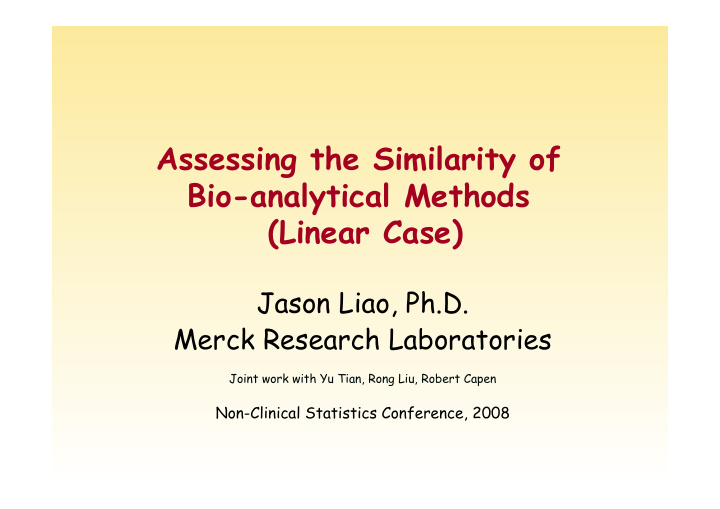



Assessing the Similarity of Bio-analytical Methods (Linear Case) Jason Liao, Ph.D. Merck Research Laboratories Joint work with Yu Tian, Rong Liu, Robert Capen Non-Clinical Statistics Conference, 2008
Outline • � Introduction • � Existing methods & potential problems • � New method • � Simulation study • � Summary and discussion 2
Introduction • � Why Similarity – � A key assumption – � RP • � Definition of similarity – � Mathematically : f (x)=g (px) – � Parallelism – � P: relative potency. 3
Introduction (cont.) • � Target: Sufficiently Similar � Single RP • � Assessing the Similarity – � Mathematically. – � The assessment of the degree of similarity is very tricky between two sparse, noisy sets of non-linear dose response data sets. – � No universal Strategy – � Two kinds of existing method: (1) Significance Test (2) Equivalence Test. 4
Significance Test (linear case: Similarity � Same Slopes) • � Significance Test Ho: Two slopes are exactly same. Ha: Two slopes are different; When the precision increases…. Lab B: Poor Precision Lab A: Good Precision � Similar � Not similar 5
Equivalence Test (linear case: Similarity= Same Slopes) • � Equivalence test Ho: |difference| >=D Ha: |difference| <D • � The equivalence limits define differences between test and standard preparations that are considered unimportant. – � Step1: CI for difference – � Step2: CI vs. Equivalence limit 6
Equivalence Test (linear case: Similarity= Same Slopes) Difference of the slopes Lab A Lab B Lab A Lab B Significance test Not similar Similar Equivalence Test Similar Not Similar 7
Equivalence Test (linear case: Similarity= Same Slopes) • � Fixed equivalence limit (Not vary with application) – � [0.8,1.25] for the ratio of the slopes • � Capability based equivalence limit (Tolerance limit) – � Manage the rate at which we falsely detect non-similarity – � Can be assessed by evaluating reference material relative to itself. 1. � For complete reference data 2. � Pair them in all possible combination 3. � set up CI…. 4. � use the most extreme boundary. 8
Equivalence Test (linear case: Similarity= Same Slopes) • � DE (dilution effect) DE=100%(2 1-bs/br -1)<=20% – � A statistic called dilution effect was introduced in the industry to assess dilution similarity. (Schofield T. 2000).The dilution effect is a measure of the percent bias per 2-fold dilution in a test samples’ value relative to that of the reference standard. – � The absolute value of dilution effect less than 20% has been used in the industry to conclude dilution similarity (parallelism) between the test sample and the reference standard 9
New Method • � Equivalence Test • � Overall difference of the response: shape of the curves 10
New Method: J-method • � J- method: • � Parallel � Considering variation…. 11
New Method: J-method (cont.) Estimate the CI for Ai • � Shift Width • � Construct Equivalence Limit (1) Width-- Variation that are considered to be acceptable Standard curve compare to itself (Tolerance Limit) (2) Shift-- 12
New Method: J-method modification (cont.) • � Deal with large variation • � Control the width of equivalence limit – � 2-fold difference boundary – � 3-fold difference boundary 13
Simulation Study • � Linear Case – � F – � DE – � J, J2, J3 14
Simulation Settings 15
16
17
18
Summary – � F: variance � , tends to conclude parallel – � DE: variance � , may not be able to get the right conclusion – � J, J2, J3: J3 works well, even when variance � 19
Discussion • � Heterogeneous Variance: Var(y)= c•(y) 2r – � New method can be easily applied Log(differe Equivalence limit nce) m 2 Shift U Width m 1 0 Level 1 Level 2 Level 3 Level 4 Level 5 20
21
Recommend
More recommend